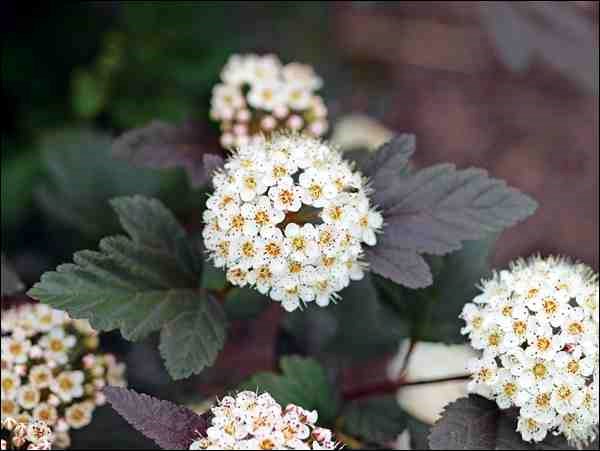Ninebarks (Physocarpus opulifolius) provide landscape value over an uncommonly long season: colourful yellow or purple foliage through summer, intensifying in fall; creamy-white flowers in spring; and deep red seedpods in late summer. A number of excellent hardy cultivars have been introduced in the last decade. One wonders how we landscaped without them.
An upright, spreading shrub of up to 2.7 metres with arching branches, ninebark is found from Quebec to Virginia. The common name alludes to the cinnamon-brown exfoliating bark, which peels to reveal a number of layers (though not necessarily nine).
The genus name is from the Greek words physa, meaning bladder and karpos, fruit, a reference to the attractive, inflated red seed pods produced in late summer. The species name, opulifolius, refers to the resemblance of its leaves to those of the European cranberry (Viburnum opulus).
Among the golden and variegated selections are:
Amber Jubilee, named to honour Queen Elizabeth's visit to Manitoba in 2010, is a cross of Diabolo and Dart's Gold. While the older foliage remains a lime green, the new growth produces shades of yellow and orange in summer, turning purple in fall. It reaches 1.8 metres in height, with a spread of 1.2 metres.
Centre Glow, a Minnesota introduction, emerges in spring with vibrant yellow green foliage, becoming red with a glowing yellow centre (2.7 metres height and spread).
Dart's Gold is a small, compact cultivar of 1.5 metres, with a spread of one metre. It has golden foliage.
Luteus has greenish-yellow foliage, the yellow being most pronounced in early spring. It has a height and spread of 2.4 metres.
Nugget, from South Dakota State University, is compact and dense but larger (1.8 metres in height, with a spread of 1.2 metres). The foliage emerges yellow, becoming lime-green in summer and yellow in fall.
Ninebarks with purple foliage include:
Coppertina, another hybrid of Dart's Gold and Diabolo, has orange-copper foliage in spring that becomes a vibrant red in fall. It reaches 2 metres (7 ft.) in height with a spread of 1.8 metres.
Diabolo, from Germany, has deep purple foliage, becoming almost iridescent red purple in the fall. It is 2.4 metres in height with a spread of 1.8 metres.
Summer Wine has been described as a condensed form of Diabolo with more deeply cut foliage. It emerges in spring a deep purple, becoming purple red in fall. A hybrid of Nanus and Diabolo, it has a dense, compact form of one metre and is excellent for smaller spaces.
Drought tolerant, ninebarks perform best if grown in full sun on well-drained soils. In shade, the yellow foliage of the golden ninebarks is much less pronounced. They may be subject to lime-induced iron chlorosis in soils with a high pH.
Place them in mixed or shrub borders or use them as foundation plantings. The yellow or purple foliage is an excellent contrast with other shrubs.
Williams is the author of the new and revised Creating the Prairie Xeriscape. In her latest book, Saskatoon Forestry Farm Park & Zoo: A Photographic History, she tells of the history of an institution and the personal stories of the people who made an important impact on Prairie agriculture.
- This column is provided courtesy of the Saskatchewan Perennial Society (www.saskperennial.ca; [email protected]). Check out our Bulletin Board or Calendar for upcoming garden information sessions. Also, visit the Canadian Prairie Lily Society at their annual bulb sale at The Mall at Lawson Heights, Oct. 3-4.




